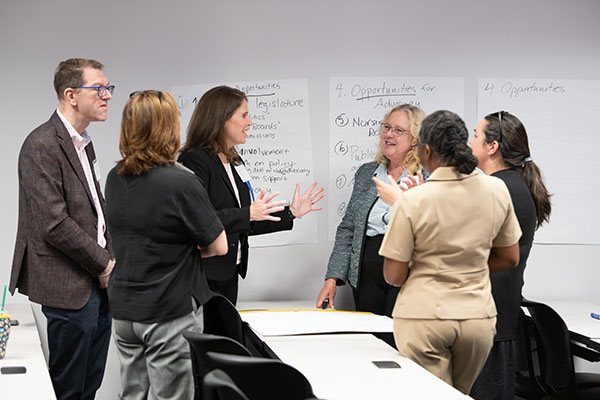“We need better data:” First Maryland Nursing Workforce Symposium Highlights Data Tracking, Legislative Advocacy in Health Care

Analyzing data about education, recruiting, and retention as well as the importance of legislative advocacy for the nursing field were key focus areas of the Maryland Nursing Workforce Center’s (MNWC) first-ever State of the Maryland Nursing Workforce Symposium: Learning from the Past, Valuing the Present, Shaping the Future.
The symposium, held June 6 in Baltimore at the University of Maryland School of Nursing (UMSON), which houses the MNWC, convened expert stakeholders from across the state to examine Maryland workforce data and trends to gain valuable insights into nursing supply, demand, and education. It also provided a platform for networking and collaboration. Through expert speakers, facilitated discussions, and small-group sessions, participants had the opportunity to connect with colleagues, exchange ideas, and strategize for the future.
“Today is an opportunity for us to become acquainted,” Crystal DeVance-Wilson, PhD ’19, MS ’06, MBA, BSN ’00, PHCNS-BC, assistant professor and director of the Maryland Nursing Workforce Center, said in her introduction.
“[The center has] expanded our focus to keep up with the needs of the Maryland nursing community and to better nursing workforces around the country,” added DeVance-Wilson, who also serves as vice chair of UMSON at the Universities at Shady Grove in Rockville, Maryland. “Data and reporting is still our core function, and we have been physically collecting data from whoever will share it.”
Maryland state Del. Bonnie L. Cullison, MA, (District 19, Montgomery County) presented the event’s keynote presentation, “The Intersection of Policy and the Nursing Workforce: Leveraging Resources for Stabilization.”
The health care system is completely reliant on “skilled, amazing, courageous, dedicated people” who give their all and more every day, said Cullison, vice chair of the House of Delegates Health and Government Operations Committee. Those in the nursing workforce have the power to affect policy changes that will improve outcomes for the state, she added.
Cullison also spoke of the importance of legislators working with those in nursing.
“I completely rely on you to inform me and my colleagues in the Legislature what factors affect your ability to practice at your highest levels and to practice effectively,” Cullison said. “There are 187 of us in the General Assembly, and most of us are open, have open doors, and listen.”
The symposium also included two panel discussions: Analyzing Maryland Nursing Workforce Data: Insights and Trends and Navigating the Complexities of the Nursing Workforce in the Modern Health Care Landscape. Deborah J. Baker, DNP, AG-ACNP, NEA-BC, FAAN, senior vice president for nursing in the Johns Hopkins Health System and vice president of nursing and patient care services and chief nursing officer for The Johns Hopkins Hospital, gave the closing address, “Putting the Pieces Together: Building for the Future Through Collaboration.”
Multiple participants took part in the morning panel about workforce data, including Kimberly Link, JD, a senior advisor for health boards at the Maryland Department of Health. Link, who was part of the Commission to Study the Health Care Workforce Crisis, broke down how the state is working not only to collect but also to analyze data regarding the workforce crisis across health care, nursing included.
“As we formed these groups and had meetings, it became very apparent that there's all this data out there from all of these different sources. How do we analyze that?” Link asked.
The workforce shortage is complex, she said, and there are many reasons that the state and the nation are in the position they’re in. Link said the commission realized answers would not come quickly or easily and set out to have findings shared with the Maryland Legislature to inform policy decisions. That’s where the work happens, she said, adding that the commission can collect and analyze data, but it needs to be shared with the Legislature, which develops the relevant laws and policies.
Link also discussed some of the information the commission discovered that can help inform future policy.
“Here’s a couple things that we found out. And again, there’s no lightning bolts here, no smoking guns. You know these things,” Link said. “The commission found that the workforce shortages in critical health care applications existed before the pandemic, and especially in nursing.”
The commission also learned that while other states such as Virginia have made progress, Maryland has not returned to pre-pandemic workforce levels. And, she said, the shortages are most prevalent in the rural areas of the state.
The biggest takeaway? “We need better data,” Link said.
“And we need a place to store it, to collect it, and to maintain it, not just to have a one-time study, a snapshot of what the nursing profession looks like at any point in time,” she added. “We need an ongoing repository of data from a lot of different sources so that we can address supply and demand issues.”
The MNWC, which was established in 2018 by a Nurse Support Program II grant funded through the Maryland Health Services Cost Review Commission and administered by the Maryland Higher Education Commission, is hoping to address these concerns.
The center’s goals include providing access to and assisting with the analysis of nursing workforce data; understanding the areas of demand and the resources needed to meet those demands; and ensuring Maryland is meeting the recommendation set forth in the National Academy of Medicine’s 2010 Future of Nursing report that calls for improving collection methods of workforce data.